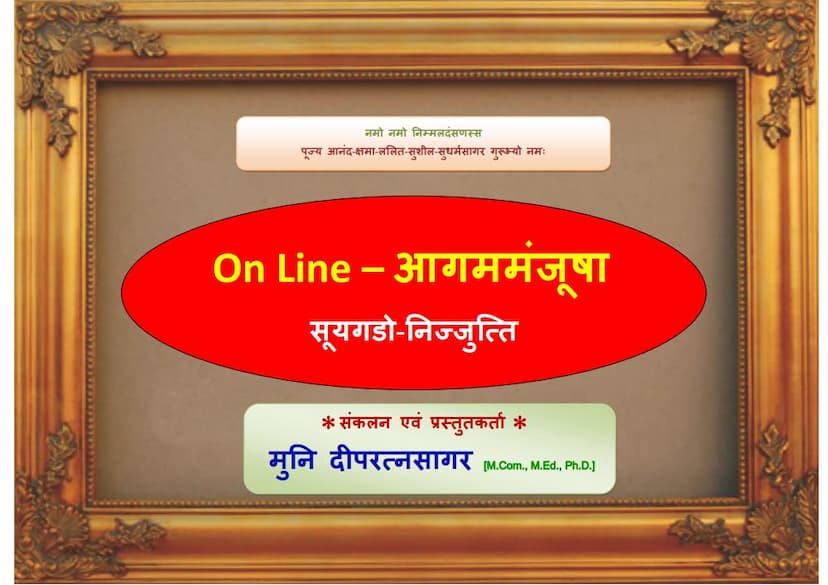Aagam Manjusha N 02 Suyagado Nijjutti
Added to library: September 1, 2025

Summary
Here's a comprehensive summary of the provided Jain text, "Aagam Manjusha N 02 Suyagado Nijjutti," based on the provided pages:
This text is a commentary and explanation of the Jain scripture Sutrakritanga, specifically its Nijjutti (a commentary or explanatory text). The work is presented as part of the "Aagam Manjusha" series, with this particular volume being the second installment focused on Sutrakritanga.
Key aspects and information from the text:
-
Authorship and Presentation:
- The original edition of "Aagam Manjusha" was edited approximately 70 years prior to the 2012 publication date (around 1942) by Acharya Shri Anand Sagar Suri.
- The current online presentation is by Muni Deepratnasagar, who has updated and enhanced the original work for the internet age.
- The publication date of this online version is given as 12/11/2012.
-
Updates and Enhancements in the Online Version:
- The online version includes original scriptures along with their Nijjutti (commentary).
- It also incorporates Bhashya (further commentary) for certain scriptures.
- Specific inclusions and changes mentioned are:
- Aavashyak Sutra (Agam-40) includes the Nijjutti.
- Jitkalpa Sutra (Agam-38) includes the Bhashya.
- The alternative scripture "Panchakalpa" within Jitkalpa Sutra also has its Bhashya included.
- The alternative Agam "Pindanniyukti" of "Oghanniyukti" (Agam-41) is included, though its printing location might differ.
- "Kalpa (Bārsā) Sutra" has also been included.
-
Content of the Nijjutti (Commentary on Sutrakritanga):
- The text begins with an invocation to the pure vision and then to the guru, Anand Sagar Suri.
- Verse 1: States the intention to describe the Nijjutti of the Sutrakritanga of the Jinas (victorious beings) and the Ganadharas (chief disciples).
- Verse 2: Lists alternative names for Sutrakritanga: Sutgata, Sutkad, and Suyagada.
- The subsequent verses detail the core concepts of Jain philosophy and ethics as explained through the lens of Sutrakritanga and its Nijjutti. These include:
- Dravya (Substance) and its aspects: This is a recurring theme, with discussions on different types of dravya (e.g., substance, application, essence, origin, extension).
- Kala (Time): The nature and classification of time are discussed.
- Bhava (State or Modality): The various states or modes of being, including those related to karma and mind.
- Niskhēpa (Classification/Categorization): The text extensively uses the concept of niskhēpa (a method of categorizing phenomena) in relation to scriptures, concepts, and karmic actions. Different types of niskhēpa (e.g., six-fold, four-fold) are mentioned.
- Karma: The workings of karma, its types, and its effects are discussed.
- Indriyas (Senses): The role and function of the five senses are explored.
- Avasthas (States/Conditions): Various states of existence, both auspicious and inauspicious.
- The nature of virtue and vice: The text elaborates on righteous conduct, wrong paths, and the consequences thereof.
- Liberation (Moksha): The ultimate goal of spiritual practice, achieved through right faith, knowledge, and conduct.
- Hellish realms (Naraka): Vivid descriptions of the torments and sufferings in the hellish regions, elaborating on the specific punishments meted out in different Naraka levels.
- Virtues: The text discusses various virtues like patience, control, knowledge, and renunciation.
- The role of the senses and mind: The impact of sensory pleasures and mental states on spiritual progress.
- The importance of dispassion: Avoiding attachment to worldly pleasures and sensory experiences.
- The nature of the soul: The soul's inherent qualities and its journey through different life forms.
- Scriptural analysis: The text delves into the methodology of interpreting scriptures, including concepts like nam, sthāpanā, dravya, kṣētra, kāla, and bhāva.
- The path to liberation: The text emphasizes the importance of the right path (samya mārga) characterized by right faith, knowledge, and conduct.
- Specific chapters and their themes: Mention is made of chapters dealing with various topics such as the importance of righteous conduct, the dangers of associating with the unrighteous, the nature of effort (virya), the path of virtue (dharma), mental concentration (samādhi), the right path (mārga), equanimity (samavasaraṇa), the nature of truth (vastu-tattva), the discipline of knowledge (jñāna), the nature of karma, and the practice of abstinence (pratyākhyāna).
- Ethical principles: The text outlines ethical guidelines for monks and laypeople, emphasizing self-control, detachment, and the avoidance of harmful actions.
- The spiritual journey: It describes the stages and challenges involved in the spiritual path, from initial adherence to the attainment of liberation.
- Biographical anecdotes: The text includes illustrative stories and examples to explain the principles, such as the story of Ahapuri, Ahsuta, and Ahaya.
The overall purpose of the "Nijjutti" is to provide a detailed and accessible explanation of the profound teachings of the Sutrakritanga, guiding the reader towards understanding and practicing the Jain way of life. The online format aims to make these valuable scriptures accessible to a wider audience.